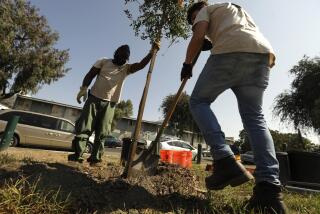Utilities Branch Out to Help Cut Cooling Costs
- Share via
A growing number of utilities in Southern California and nationwide are turning to a decidedly low-tech way of pushing energy conservation: trees.
Customers in Anaheim, Riverside and soon in Los Angeles can get shade trees, meant to cool houses naturally, through utility programs that offer free trees or rebates.
This year, as California’s summer heats up with an energy crisis, the number of requests for free shade trees in Anaheim is up 51%, to 565, from 375 last May and June. Since the program’s start in 1992, more than 16,000 trees have been planted through the city-owned utility. Customers receive up to three free 15-gallon trees, plus rebates of up to $20 for three more.
“Energy conservation is on the top of everyone’s mind right now,” said Melanie Nieman, spokeswoman for Anaheim Public Utilities.
In 1991, the American Public Power Assn. launched its nationwide Tree Power initiative to encourage utilities to plant trees in their communities as a way to save energy and reduce air pollution.
Since then, 165 of the nation’s more than 2,000 community-owned electric utilities have started shade-tree programs.
Strategically planted shade trees can significantly reduce the use of energy for cooling, said Hashem Akbari, leader of the Heat Island Group at Lawrence Berkeley National Laboratory in Berkeley.
His group conducted studies that found shade plus the cooling from evaporation by trees reduce the air temperature around a home. Studies conducted by Akbari’s group found summer daytime air temperatures to be 3 to 6 degrees cooler in tree-shaded neighborhoods than in treeless areas.
“In moderate climates when the demand for summer cooling is very small, trees can potentially eliminate your need for cooling,” he said. “However, in inland areas where an extensive amount of cooling is required, strategically planted trees can save 10% to 15% of summer cooling load, which would produce an annual savings of $30 to $50.”
Kris and Mathew Barnett of Anaheim received two free trees through Anaheim Public Utilities’ TreePower program in March--a pink orchid and an ornamental pear--which they planted in their front yard to eventually shade two bedroom windows of their 1950s ranch-style house. The utility offers a choice of 50 varieties of trees, which typically retail for $35 to $55.
“We’re hoping that they will add to the energy efficiency of the new air-conditioning system we put in,” Kris Barnett said. “We live in an older house that’s not very well insulated so we want to do whatever we can to improve energy efficiency.”
Since starting its program two years ago, Riverside Public Utilities has offered customers rebates on 3,500 shade trees--up to $25 per tree, with a limit of five trees a year.
In September, the Inland Empire Utilities Agency in Fontana, working with school and civic groups, will launch its tree program by donating trees for community plantings.
“The topic of the hour is how to reduce energy costs in cooling our buildings, but planting trees also will help to address improved air quality, address reducing global-warming gases and contribute to water conservation,” said Martha Davis, the utility’s manager of strategic policy development.
Considered the largest mass tree-planting, utility-funded program in the nation, Sacramento’s Shade Tree program has given away more than 300,000 five-gallon trees to some 100,000 households since 1990.
The program has an annual budget of $1.5 million. Last year, nearly 10,000 people signed up.
In October, the Los Angeles Department of Water and Power will launch its tree giveaway program: Trees for a Green L.A.
Funded under the department’s public-benefits program, the $8-million, two-year pilot program will provide 200,000 free trees to be planted near residences, public buildings, in public spaces and at new construction projects throughout the city. Residential customers will be allotted up to seven, five-gallon trees.
The trees ultimately will reduce various pollutants by thousands of tons, said Angelina Galiteva, director of strategic planning.
After the trees mature, “We expect to reduce cooling energy use by more than 16,000 megawatt hours per year, or 81 kilowatt hours for every tree planted per year,” she said.
Trees for a Green L.A. comes on the heels of the the utility’s Cool Schools program, which has planted 4,500 free trees at more than 45 Los Angeles schools over the last two years.
Some of the programs deliver the trees; others expect customers to pick them up. Though homeowners are responsible for planting, the utilities offer tips and, in some cases, site inspections.
Ron Vanderhoff, nursery manager at Roger’s Gardens in Corona del Mar, said it takes at least four years for a typical 15-gallon tree--about 8 feet tall--to grow enough to provide a significant amount of shade, and about 15 years to mature fully.
Eight years after receiving their first two free trees from the TreePower program, Gloria and Gabriel Criscuolo of Anaheim have finally started seeing a payoff.
They planted the trees--a camphor and a New Zealand Christmas tree--next to the western, “sunny side” of their house.
The camphor tree, Gloria Criscuolo said, is now nearly 10 feet tall and provides ample shade for their dining room windows. The slower-growing New Zealand Christmas tree is providing some shade but still has a way to go.
Still, the Criscuolos figure they saved $20 a month on their summer utility bills last year because of the shade.
More to Read
Inside the business of entertainment
The Wide Shot brings you news, analysis and insights on everything from streaming wars to production — and what it all means for the future.
You may occasionally receive promotional content from the Los Angeles Times.










